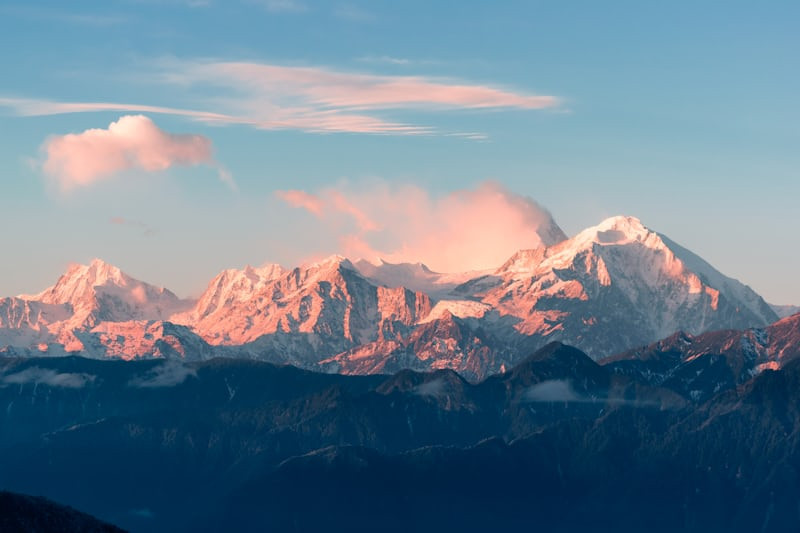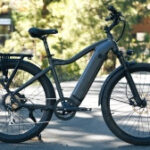Riding a fat bike in the snow? The thought might conjure images of slow, arduous pedaling, battling layers of clothing to stay warm without overheating, and monotonous trails. Perhaps you envision something akin to the grueling Iditabike race in Alaska – a test of endurance in extreme cold and desolate landscapes. These were the very misconceptions I held about winter fat biking before I actually tried it. I imagined it as all the challenges of regular cycling amplified by freezing temperatures and unforgiving terrain. Living in Park City, Utah, I was aware of the meticulously groomed trails, but I couldn’t quite grasp how enjoyable snow biking could truly be, especially compared to summer dirt riding. Skiing and snowboarding were my winter sports of choice. However, I was completely mistaken. What I discovered was a cycling discipline that stands shoulder-to-shoulder with XC, downhill, and gravel riding – a winter passion I’m now deeply committed to.
 Winter Solstice over Park City, Utah, 2019
Winter Solstice over Park City, Utah, 2019
Let me address those common myths about snow biking, particularly regarding speed. It’s true, it’s not as fast as riding on dirt, but “sluggish” is far from the reality. A lot depends on snow conditions, which, admittedly, are highly variable. This ever-changing surface is part of the unique appeal of snow biking. When the snow is perfectly packed, the trails can be just as exhilarating as dirt tracks, offering a distinct riding experience. From the way the tires grip the snow to how you balance your weight and brake into turns, it’s a different kind of thrill. And one of the most liberating aspects? Crashing becomes an almost consequence-free event. Falls are inevitable, but they are usually soft landings, allowing you to really push your boundaries and explore the limits of your bike, tires, and the snowy terrain.
When it comes to winter cycling apparel, finding the right balance is crucial, just like in any season. You need to ventilate enough on uphill climbs to prevent excessive sweating, and then insulate effectively for descents to avoid a bone-chilling cold. Fortunately, modern fabric technologies make this balance achievable and even quite precise.
Terrain diversity is another pleasant surprise in fat biking. While some trails are wide and groomed, shared with cross-country skiers, places like Park City boast extensive networks of groomed singletrack trails dedicated to bikers and hikers. After a fresh snowfall, these trails transform into thrilling bobsled runs. As time passes between snowfalls, they become progressively firmer and faster. Interestingly, snow biking conditions often improve as ski conditions deteriorate. I often find myself dropping my kids off for ski team at Deer Valley and then heading straight to the trails for a fantastic fat bike ride, opting for the snow bike over hard, icy ski slopes.
Like any cycling discipline, winter fat biking is heavily reliant on the right gear. Here’s a look at my preferred setup:
Trek Farley 9.6 Fat Bike
The fat bike category largely maintains the original 26-inch wheel standard. However, more contemporary designs are moving towards 27.5-inch wheels, which is the direction Trek has taken with their flagship fatty, the Farley 9.6. The larger circumference provides a greater contact patch and reduces rolling resistance, allowing for slightly narrower tires, typically 4.5 inches versus 4.8 inches.
The core of this bike is its OCLV carbon fiber frame and fork, which are remarkably light and rigid. You’ll notice the absence of suspension, which is unnecessary for snowy terrain. The snow itself is a very forgiving surface, cushioning rocks and ruts effectively. With tire pressure as low as 8 PSI, the tires provide all the suspension you need. Despite its bulky appearance, the bike is surprisingly light, weighing in at 28 pounds, 12 ounces with pedals and a dropper post. Like a powerful linebacker, it’s deceptively agile and quick for its size.
Drivetrain and Components
The drivetrain is perfectly suited for snow biking: SRAM’s NX Eagle entry-level groupset with a 12-speed, 10-50t cassette and a 30t chainring. Newer models often upgrade to the GX Eagle group with a wider 10-52t cassette. One of the great things about snow biking is the minimal maintenance and wear on components, thanks to the absence of dirt and grit. Simply drying the chain and keeping it lubricated is usually sufficient. Strava times become less of a concern in the snow, as they won’t compare to dirt riding. However, gear range is crucial, as soft snow conditions can demand high cadence pedaling.
Upgrades: Dropper Post and Handlebar
I made a couple of key upgrades to the stock Farley 9.6. Firstly, a dropper post is indispensable for snow riding, and it’s now standard on the latest Farley 9.6 models. A lower center of gravity significantly improves tire grip when navigating sweeping turns on shifting snow surfaces. I chose the FSA Flowtron dropper post – a cost-effective ($249) option that performs reliably in freezing temperatures. The Farley frame includes internal routing, making installation straightforward. I also replaced the stock aluminum handlebar with the FSA Gradient Carbon 35 20 Riser handlebar to reduce weight and enhance handling.
Pedals: Crank Brothers Mallet E LS
Pedal choice for snow biking is significant. Many riders opt for flat pedals due to the frequency of unexpected dismounts and the lesser importance of pedaling efficiency compared to clipless pedals. However, I prefer the added control of being clipped-in, while still wanting a stable platform and a system that functions well in wet conditions. This led me to the Crank Brothers Mallet E LS pedals, designed as enduro pedals with a longer spindle. The Crank Brothers “egg beater” cleat mechanism performs exceptionally well in wet environments, and the Mallet design includes six adjustable traction pins to keep shoes secure, whether clipped in or not. Cleats can be set for 10 or 15 degrees of float, depending on rider preference for release angle.
Tires: 45NRTH Dillinger Studded Tire
More than anything, tire selection dictates a fat bike’s snow handling. The Farley comes with Bontrager Barbegazi Team Issue 4.5-inch tires, front and rear. The square knobs are widely spaced and perform well in the rear, providing good traction for climbing and ample braking power. However, they are not ideal for the front. I swapped the front tire for the 45NRTH Dillinger 4.5-inch Studded tire. Its angled center tread and “slice-y” side knobs offer improved cornering stability, crucial in snow biking where front tire grip is often the limiting factor. The studded version features 252 concave aluminum carbide studs. While overkill for purely snow conditions, they provide maximum front-tire grip, especially valuable on icy patches.
For the current season, Trek offers several Farley models ranging in price, all built around 27.5-inch platforms with similar riding characteristics. Any of these are excellent choices for getting into fat biking.
Transportation: Thule T2 Pro XT Receiver Rack
Winter snow biking often requires driving to trailheads, making bike transport important. The Thule T2 Pro XT is a two-inch receiver rack designed to carry two bikes with tires up to five inches wide. It has a large tray for the front wheel, which adjusts down for road tires, and a ratchet-strap for the rear tire. Adjusting the strap anchor point easily accommodates fat tires. Paired with a vehicle like a Jeep Wrangler Unlimited Rubicon, the Thule Access swing-out adapter is incredibly useful, allowing the rack to swing away for tailgate access and fold up while clearing the spare tire.
Winter Cycling Apparel: Staying Warm and Comfortable
Assos Bonka EVO Bib Tights
Warmth, comfort, and performance are hallmarks of Assos bib tights. After testing other brands, I found that overly heavy leg material could slip down, pulling the chamois and causing chafing. Assos bib tights address this with their form-fitting design and strategic fabric placement. Highly insulated “RX Heavy” fabric is used in the knee, hip, and thigh areas for extra warmth, while more breathable and flexible “RX Light” fabric is placed at the back of the legs. They fit like a second skin and stay in place. The cuffs feature a wetsuit-like material that repels water and snow while maintaining a snug seal.
45NRTH Naughtvind Shell Pant
Similar to overshorts for summer mountain biking, these shell pants layer over bib tights for winter snow biking. Key features include an excellent riding fit with a high back waist to block out the elements and a low front waist to prevent bunching. Velcro cinch straps at the waist and cuffs, front leg vents with zippers and Velcro for precise ventilation control, strategically located side pockets for snacks that don’t interfere with pedaling, a reinforced crotch for durability, and stretch construction for maximum movement. These Naughtvind Shell Pants are an essential snow biking layer. While lighter bib tights might suffice in warmer conditions, these pants are a constant for me. They also happen to look great.
Shimano MW7 Shoes
Shimano’s top-tier winter mountain bike shoe is designed for cold, wet, and snowy conditions. It features an insulated, waterproof GORE-TEX liner and a wetsuit-style cuff that fully covers the ankle. Even when stepping into deep snow, my feet remained warm and dry. A fleece-lined insole adds to the slipper-like comfort. The Michelin sole is aggressive and grippy for hike-a-bike sections, which are sometimes unavoidable, and the Boa lacing system allows for precise adjustments on the go.
Pearl Izumi Interval AmFIB Jacket
Pearl Izumi excels in winter apparel, perhaps due to their Colorado roots. For 30 years of cycling, I’ve consistently relied on Pearl Izumi for cold-weather jackets. The Interval AmFIB jacket became my go-to layer last winter. Depending on the day’s conditions, I would pair it with different base layers and vests for temperatures ranging from 15 to 50 degrees Fahrenheit. This jacket feels remarkably light but provides exceptional warmth. Front-facing zippered vents allow for airflow adjustments, and the cuffs feature a tight inner liner to block out wind.
Essential clothing accessories include the 45NRTH Baklava, the Assos Winter Cap, and the Pearl Izumi AmFIB Lobster Gel Gloves. I found a winter helmet generally unnecessary, and 45NRTH pogies were only needed a couple of times in very cold conditions. Mid-day temperatures often made them unnecessary, but they are crucial for temperatures around zero degrees Fahrenheit and below.
Embrace the Winter Ride
Fat Wheel Bikes open up a whole new world of cycling during the winter months. Dispelling the myths of sluggish rides and uncomfortable conditions, fat biking offers an exhilarating and unique way to experience snow-covered trails. With the right gear and an adventurous spirit, you might just find yourself, like me, eagerly anticipating the next snowfall, ready to hit the trails on your fat bike.


